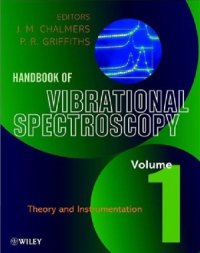
Ebook: Handbook of Vibrational Spectroscopy
- Genre: Chemistry // Analytical Chemistry
- Tags: Химия и химическая промышленность, Аналитическая химия, Физико-химические (инструментальные) методы анализа
- Language: English
- zip
John Wiley & Sons Ltd, Chichester, 2002. - 4484 p.This article is entitled the historical development, rather than the history, of experimental techniques in vibrational spectroscopy because the author is not a professional historian. Also, this summary account of a very large subject necessarily depends substantially on a number of more detailed articles that record the primary sources for particular areas. At the beginning of each section, these other sources are listed. The majority of the original references can be found in these; apart from exceptionally important ones, the primary references given are those not readily to be found in the other sources.
The article is divided into sections. The Laying of the Foundations: The Period to 1945 covers the initial period during which sound experimental techniques and theoretical understandings were developed for molecular vibrational spectroscopy in the infrared (IR) and Raman regions. This spans the period between the discovery of the IR region of the spectrum by Sir William Herschel in 1800 and the summary of the achievements of these two principal forms of vibrational spectroscopy in the book Infrared and Raman Spectroscopy of Polyatomic Molecules written by Gerhard Herzberg and published in 1945. By the latter date, the interpretation of such spectra had become well established through the application of quantum theory.
As a result of technical experimental developments during the Second World War, IR spectroscopy in particular was poised in 1945 to make new and major contributions to molecular structural analysis and to the qualitative/quantitative analysis of mixtures. This subsequent period, up to the year 2000, was marked by several major experimental advances, which are discussed in the second part of the article entitled The Period, since 1945, of Multiple Applications of the IR and Raman Spectroscopies. This period is one of which the author has had consider- able personal knowledge since starting in 1943 as a research student using IR spectroscopy for wartime research. During this period, the use of vibrational spectroscopy increased greatly decade by decade so the account given here constitutes only an introductory outline.
Since the mid-1960s, several additional methods of obtaining vibrational spectra have been developed, which have important but specialized areas of application. These are described and evaluated in the third part of the article under the heading The Newer Vibrational Spectroscopies.
The article is divided into sections. The Laying of the Foundations: The Period to 1945 covers the initial period during which sound experimental techniques and theoretical understandings were developed for molecular vibrational spectroscopy in the infrared (IR) and Raman regions. This spans the period between the discovery of the IR region of the spectrum by Sir William Herschel in 1800 and the summary of the achievements of these two principal forms of vibrational spectroscopy in the book Infrared and Raman Spectroscopy of Polyatomic Molecules written by Gerhard Herzberg and published in 1945. By the latter date, the interpretation of such spectra had become well established through the application of quantum theory.
As a result of technical experimental developments during the Second World War, IR spectroscopy in particular was poised in 1945 to make new and major contributions to molecular structural analysis and to the qualitative/quantitative analysis of mixtures. This subsequent period, up to the year 2000, was marked by several major experimental advances, which are discussed in the second part of the article entitled The Period, since 1945, of Multiple Applications of the IR and Raman Spectroscopies. This period is one of which the author has had consider- able personal knowledge since starting in 1943 as a research student using IR spectroscopy for wartime research. During this period, the use of vibrational spectroscopy increased greatly decade by decade so the account given here constitutes only an introductory outline.
Since the mid-1960s, several additional methods of obtaining vibrational spectra have been developed, which have important but specialized areas of application. These are described and evaluated in the third part of the article under the heading The Newer Vibrational Spectroscopies.
Download the book Handbook of Vibrational Spectroscopy for free or read online
Continue reading on any device:

Last viewed books
Related books
{related-news}
Comments (0)